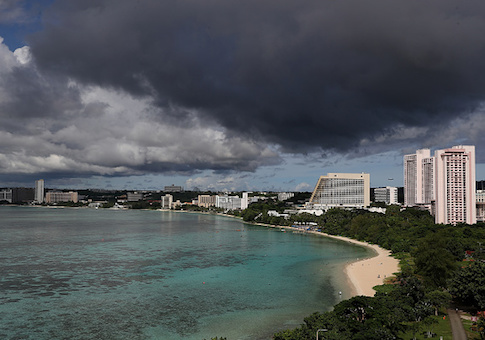The governor of Guam, the U.S. territory in the crosshairs of a North Korean missile threat, is confident the tiny island has all the military defense capabilities needed to shield against an attack by the Kim Jong Un regime.
Gov. Eddie Calvo, who spoke to the Washington Free Beacon from the governor's mansion over FaceTime, wearing a colorful Hawaiian shirt, noted the missile defense systems on Guam and its surrounding territories, including U.S. military ships deployed off the coast, as credible protections against attack.
"I don't mean to downplay the threat, but do I look like a stressed out guy?" he said, laughing. "Look, when it comes to a missile attack, especially nonnuclear, Guam is probably the best—I don't mean to brag—but the most prepared of any American community."
The sentiment was echoed by a spokesman for the Joint Region Marianas, who said in an email the military command "always maintains a high state of readiness and has the capabilities to counter any threat, so additional elevated measures were not required."
Though North Korean leader Kim Jong Un on Wednesday backed off an earlier threat to strike Guam with four intermediate-range ballistic missiles, he warned he could swiftly reverse the decision depending on the actions of the "foolish Yankees."
The threat to attack Guam was not Kim's first. North Korea has used Guam as a pawn several times before, given its close proximity to Pyongyang and value to the U.S. as a strategic military outpost in the Pacific. The island is 2,100 miles southeast of Pyongyang, closer to North Korea than it is to Hawaii, and lies some 8,000 miles away from Washington, D.C.
The U.S. military, which already owns one-third of the island, is planning to expand its presence there within the next four years through the construction of a Marine Corps base. Guam is currently home to Naval Base Guam and Anderson Air Force Base, which houses the Terminal High Altitude Area Defense System, or THAAD, anti-ballistic missile defense system.
THAAD was installed on Guam in 2013 after North Korea announced Anderson Air Force Base was within "striking range." The platform is designed to track, intercept, and destroy short, medium, and long-range missiles before they can reach their target. THAAD so far has a 100 percent success rate in its 13 flight tests since 2006, according to Reuters.
The missile defense system is a key component to the United States' deterrence operation against North Korea. President Donald Trump has also threatened to unleash "fire and fury" on North Korea in response to any provocation.
Calvo lauded Trump's hardline statements. He said the United States needed to make very clear to Kim the consequences of attacking American soil.
"I don't want to see the destruction of North Korea, but I want to see my president tell the world that if they attack Guam, then the consequence is the annihilation of their regime," he said.
"Still, as much as I send the message that we've got to be clear with [Kim] of the consequences, war must be the last and ultimate option if no other form of diplomacy can halt the development of nuclear weapons and missile technology," he said. "Right now, there are too many other ways to continue to move on this short of war."
Calvo, like the president, said China is the key to rein in the Kim regime. Beijing, which accounts for 90 percent of North Korean trade, announced last week it was banning the import of iron, lead, and seafood, among other imports from Pyongyang, as part of recently passed United Nations sanctions.
It's too early to tell what impact those sanctions will have on Kim's nuclear ambitions.
